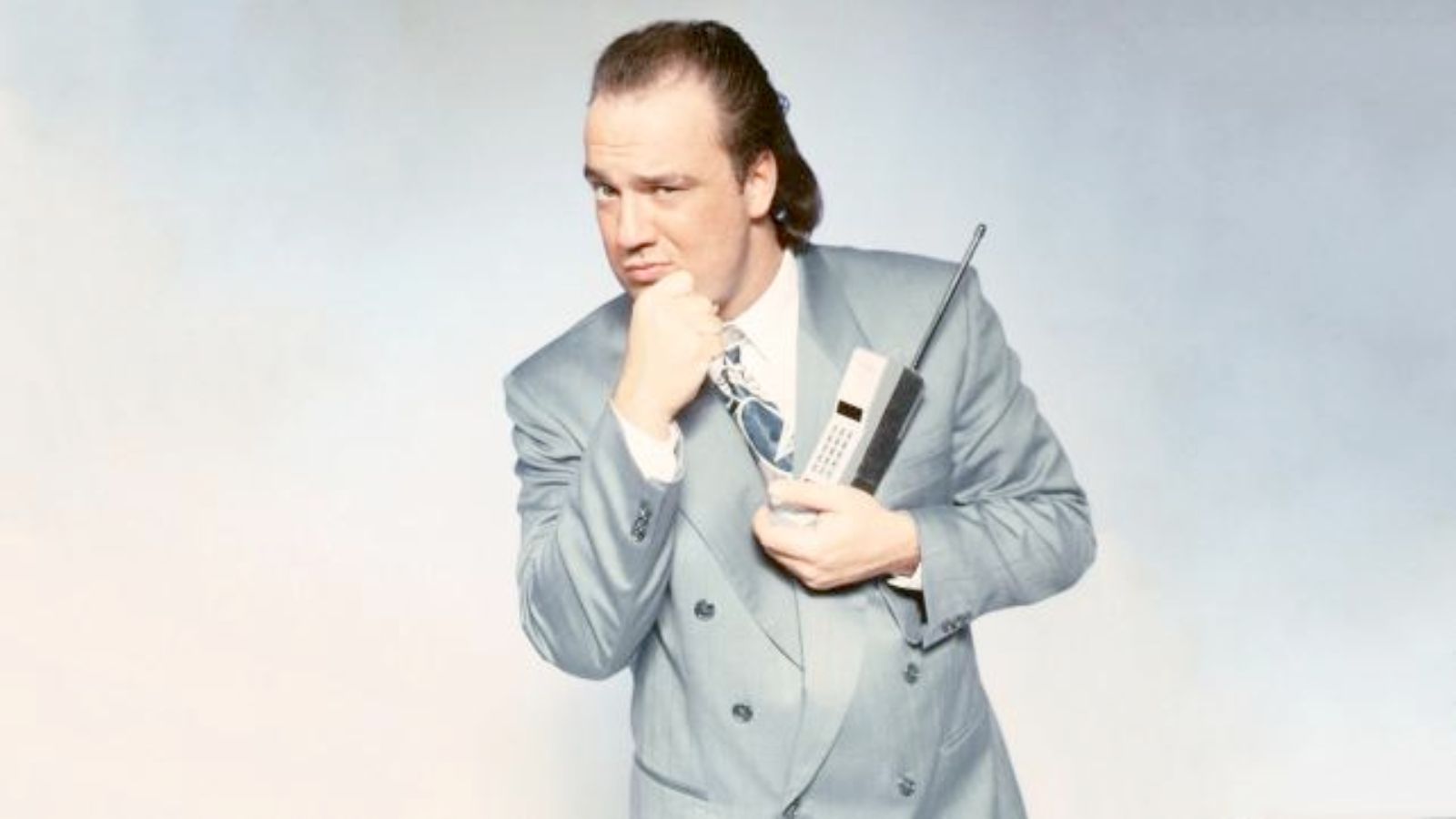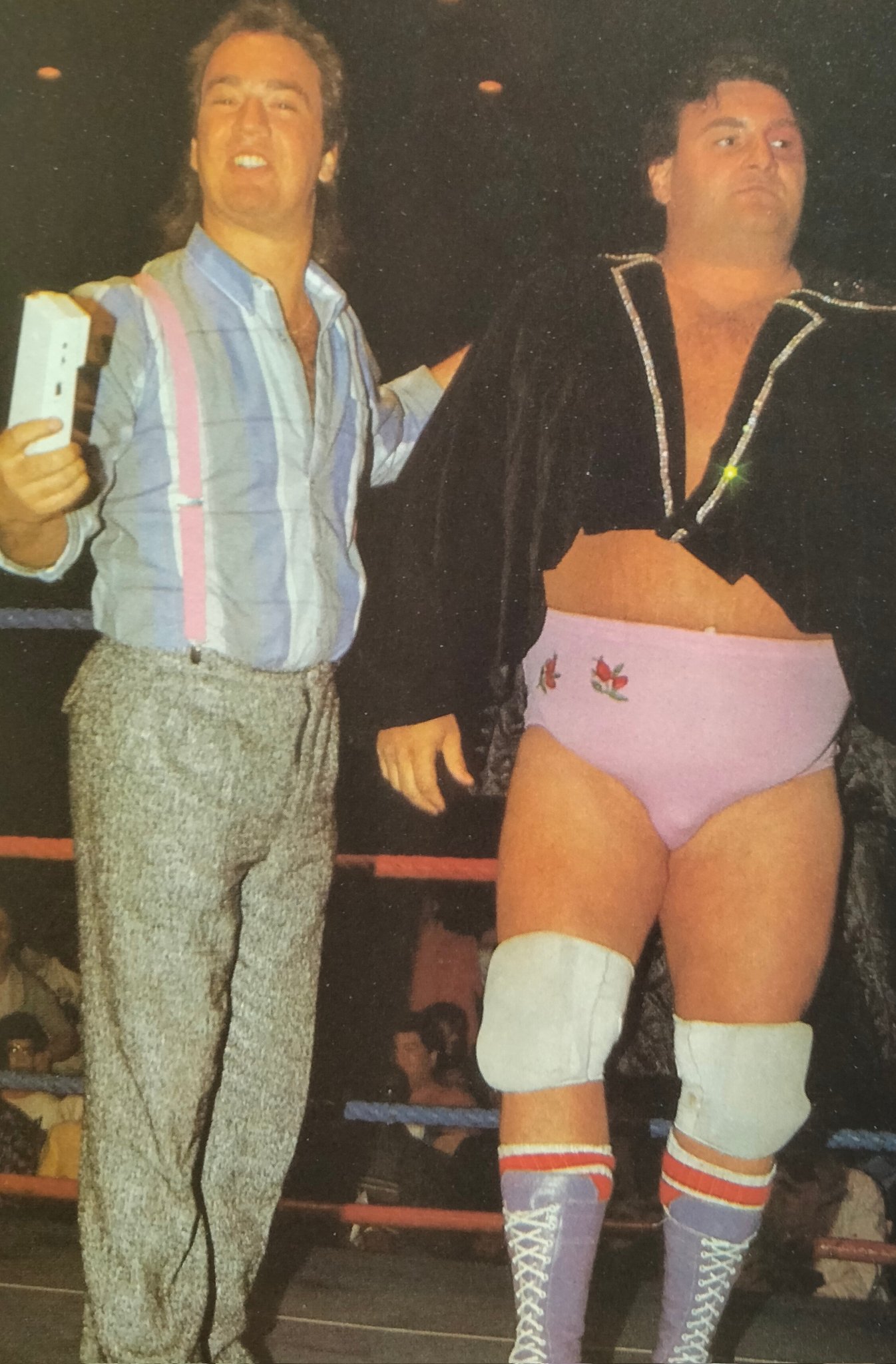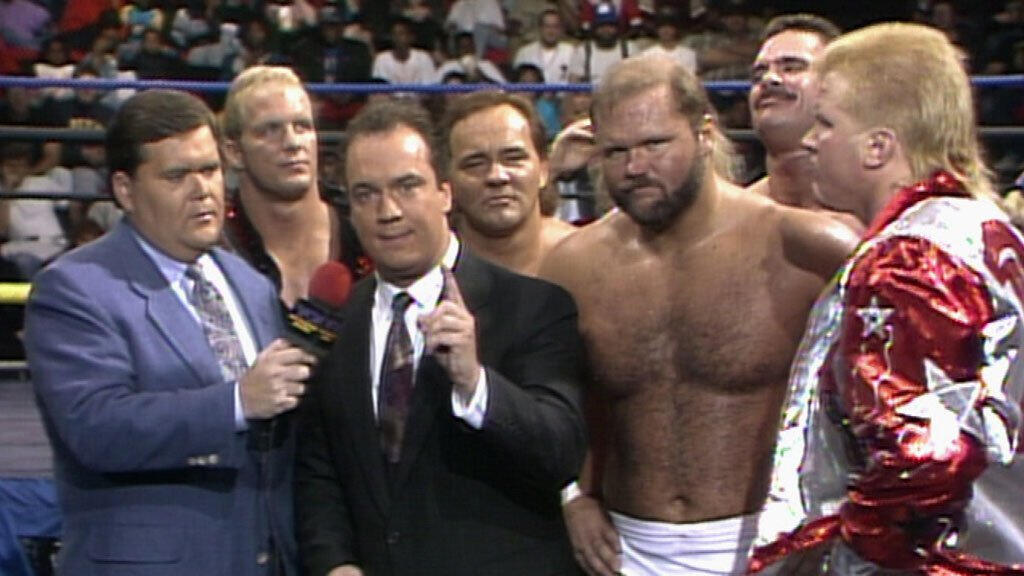In a 2022 interview with Ryan Satin, Paul Heyman said of his life that he’s never held a real job. Whether it was selling sports memorabilia from his family home, taking pictures of local wrestlers in the New York area, producing events at Studio 54, or booking for the 3rd biggest pro wrestling promotion in North America, Heyman never thought of his work as a “real” job.
“I worked around people who had real jobs,”
Heyman told Ryan Satin. According to Heyman, the people who did lighting for Studio 54 or the camera operators at WWE events were the people with “real” jobs. In his own words, every job Paul Heyman ever had was a hustle.
Whether he lied to the Capitol Wrestling Corporation to get backstage at Madison Square Garden or genuinely became the top heel manager in WCW, Heyman feels like his life has been a tightrope walk.
Paul Heyman’s legacy of hustle, from his early business ideas to his time managing the top stars in the WWE. Along the way, we hope to illustrate how Paul Heyman became one of the most loved and sometimes most hated man in pro wrestling.

Paul Heyman –
Beginnings
“The most influential moment of my life actually happened 20 years before I was born,” Heyman told Slam Wrestling in 2009, “
…when the British soldiers liberated Bergen-Belsen on April 15, 1945.”
Paul Heyman was born on September 11th, 1965 in the Bronx section of New York City. His mother, Sulamita Szarf was a survivor of The Holocaust, having suffered in the Łódź Ghetto in Poland before being sent to Bergen-Belsen and Auschwitz.
Paul’s father, Richard Heyman, served in the US Navy during WWII and became a personal injury attorney upon his return to the United States. Heyman would later say of his upbringing:
“I grew up in a household with my mother, who was a Holocaust survivor. I very much understand the mentality that you cannot live in the past.
You can’t spend your entire life, or even portions of it, looking back and dwelling on things that have already happened. You have to move forward.”
While he was not a particularly athletic youngster, the young Paul had a fascination with sports, and at age 11 he began selling memorabilia by mail from his family home.
However, his favorite sport was pro wrestling, and by age 13 he had begun publishing his own newsletter, The Wrestling Times Illustrated. However, his newsletter needed photographs, and that led him to purchase his own camera and photo lab.
This began the first act of his career in pro wrestling, taking photos of wrestlers in the New York area.
The following year, he made a call to the Capitol Wrestling Corporation, then-owners of the WWWF, and convinced them to give him backstage passes for an upcoming event at Madison Square Garden.
The WWWF was pleased with his photos, and offered to pay him for more photography work. Through this, he was able to connect with and learn from the top 3 managers in the region: “Classy” Freddie Blassie, “Captain” Lou Albano, and “The Grand Wizard” Ernie Roth.
Later on, he would pull a similar stunt with Jim Crockett Promotions, sneaking into a production meeting where he would learn more about the inner workings of the pro wrestling world.
Upon graduating from Edgemont High School, Heyman enrolled in the State University of New York, where he gained notoriety as a colorful, outspoken, and sometimes controversial on-air personality at the SUNY and Westchester Community College radio stations.
Also around this time, he would receive a job offer from New York club owner Steve Rubell, becoming an in-house photographer at the infamous Studio 54.
Through what would become his trademark hustle, Heyman worked his way from photographer to producer to promoter.
Among his most noteworthy accomplishments was the WrestleParty 85 event, which featured appearances by Ric Flair and Magnum T. A. along with the debut of Bam Bam Bigelow.
Heyman and Bigelow developed a connection that night, and Bam Bam would be the one to suggest that Heyman pursue a career as a manager.
And so, starting in January of 1987, Paul Heyman would debut as a manager, working on the independent circuit in the New York area before moving to his first high-profile wrestling gig in February.
Paul E. Gets Dangerous
Working for Eddie Graham in the Florida territory, Heyman joined forces with top heel Kevin Sullivan and the outgoing manager Oliver Humperdinck.
It was during this time that he would acquire his most famous pseudonym, after the wrestlers noted his likeness to Michael Keaton in the 1984 crime-comedy Johnny Dangerously.
As Paul E. Dangerously, Heyman incorporated his own personality as a loudmouth New Yorker, and but blended it with the intensity of Gordon Gekko from 1987 crime thriller Wall Street.
Paul E. Dangerously was never far from his mobile phone (a new and exciting invention at the time) with which he allegedly made big money deals.
However, more often than not, he used the heavy, blocky, old cell phone as a foreign object, clonking the babyfaces over the head to give his wrestlers an edge.
Heyman’s stint in Championship Wrestling from Florida was short-lived, however, as Jim Crockett purchased the promotion in an effort to unify a number of NWA affiliates and counter the WWF’s national expansion.
With CWF now closed, Heyman went to Memphis to work with his old friend Bam Bam Bigelow. In the Continental Wrestling Association, Heyman would begin as a manager for future champion Sid Eudy under the moniker of “Lord Humungus.”
By the end of his time in the CWA, Paul E. Dangerously would manage Austin Idol and Tommy “Wildfire” Rich in their feud with perennial Memphis babyface Jerry “The King” Lawler.
This feud would spill over into the American Wrestling Association in Minneapolis, where Paul Heyman would start on his ultimate path through the pro wrestling industry.
Dangerous Allies
In the spring of 1987, while working for the AWA, Paul Heyman would become the new manager to Adrian Adonis, fresh off his stint in the WWF, and The (Original) Midnight Express.
Under the management of Paul E. Dangerously, the quartet would take on the moniker of The Dangerous Alliance. On the October 30th, 1987, Dennis Condrey and Randy Rose would defeat Bill Dundee and Jerry Lawler for the AWA World Tag Team Championships.
Meanwhile, Adrian Adonis would make it to the finals of the AWA International Television Championship tournament before taking a DQ loss to inaugural champion Greg Gagne.
However, a behind-the-scenes dispute between Dennis Condrey and Verne Gagne led to The Midnight Express’s departure from the AWA at the start of 1988, along with the dissolution of the original Dangerous Alliance.

Formerly H & H International, the trio would take on the Dangerous Alliance moniker in both the CWA and Continental Wrestling Federation. In those days, Eddie Gilbert was the booker at the CWF, and he decided to take Paul Heyman on as his assistant booker.
This allowed him to receive tutelage from one of the brightest minds in the industry while also trying out his own ideas as booker for Chicago-based indie promotion Windy City Wrestling.
This arrangement with Gilbert was short-lived, however, as by the end of 1988, a new employer had come knocking.

Paul E. Dangerously in WCW
In 1988, media mogul Ted Turner bought Jim Crockett Promotions and re-branded the whole enterprise as World Championship Wrestling.
Among his top priorities after coming into the wrestling business was snapping up the best talent not currently signed to the WWF. This included Eddie Gilbert (who had worked for the company previously), Missy Hyatt, and Paul E. Dangerously.
In WCW, Heyman was re-united with Dennis Condrey and Randy Rose, whom he managed in their feud with Bobby Eaton, Stan Lane, and manager Jim Cornette in “The Battle of The Midnight Expresses.”
Following Condrey and Rose’s departure from WCW in 1989, Heyman would become the manager for the debuting Samoan SWAT Team and “Mean” Mark Callous, who would sign with the WWF and become The Undertaker just one year later.
However neither prospect was a good fit for Paul E. Dangerously as a manager, and in 1990 he settled into a role on commentary with Jim Ross.
Paul Heyman speaks highly of Ross in both his book and documentary, saying of his time working with JR that he learned more than he did under any other mentor.
Early in the Fall of 1991, in the absence of top heel Ric Flair, WCW went about re-structuring the heel side of their talent pool, and this called for Paul E. Dangerously to return as a manager.
After being kayfabe ‘fired’ from his position on commentary, Dangerously appeared at that year’s Halloween Havoc. In an infamous interview segment, he reminded the company that while he was fired from commentary, he still kept a manager’s license.
To that end, he called out The WCW Phantom, a masked character who had defeated up-and-coming Tom Zenk in a squash match earlier that night. After re-introducing himself as a manager, his new client unmasked to reveal himself as “Ravishing” Rick Rude.
The following month at Clash of The Champions XVII, Dangerously and Rude would concoct a plan with then-babyface Bobby Eaton to defraud Sting of his WCW United States Championship.
The ruse fell through when Sting made it to the ring in time to defend against Rick Rude, but The Ravishing One took advantage of Sting’s recently re-injured knee to capture the gold.
Despite having failed in his role, Bobby Eaton became a client of Paul E. Dangerously. However, this was just the beginning of Paul E. Dangerously’s revenge on WCW. As it turns out, sometimes the third time really is the charm.

The Third Dangerous Alliance
On the episode of WCW Saturday Night, immediately following Clash of The Champions XVII, Paul E Dangerously announced the formation of a new Dangerous Alliance.
This third incarnation of Heyman’s infamous alliance would consist of Rick Rude, Bobby Eaton, Arn Anderson, Larry Zbysko, Madusa, and the recently-debuted “Stunning” Steve Austin.
Over the next six months, The Dangerous Alliance would run roughshod over the WCW locker room. At their height, The Dangerous Alliance held the United States Championship (Rude), the WCW World Tag Team Championships (Anderson & Eaton) and the WCW World Television Championship (Austin).
The Dangerous Alliance’s reign of dominance culminated in one of the goriest WarGames matches ever, at WrestleWar ’92.
The Alliance’s opponents that night were a collection of the top babyfaces in WCW: Sting, Ricky Steamboat, Dustin Rhodes, Barry Wyndham, and Nikita Koloff.
However, an errant strike by Zbysko to Bobby Eaton cost them the match when Sting capitalized and forced Eaton to submit to an armbar.
As a result of his mistake in the WarGames match, Dangerously cut Zbysko from the group. This would signal the beginning of the end for The Dangerous Alliance.
Rick Rude would leave the group, taking on Madusa as his personal valet before suffering a legitimate neck injury in December. Arn Anderson and Bobby Eaton attempted a partnership with former Freebird Michael Hayes.
Meanwhile, “Stunning” Steve Austin developed a chemistry with “Flyin'” Brian Pillman, leading to the formation of The Hollywood Blondes, who would be managed by Colonel Robert Parker.
Paul E. Dangerously’s final appearance on WCW Television came at Clash of The Champions XXI, in November of 1992, where he wrestled Madusa to a time-limit draw. He was unceremoniously fired at the end of the year.
Heyman and Arn Anderson are both of the opinion that, while The Dangerous Alliance could have been the biggest thing in pro wrestling, their downfall was the result of choices by then-WCW president Bill Watts.
However, while Anderson chalks it up to incompetence, Heyman believes Watts deliberately sabotaged them.
Heyman says the first time he met Bill Watts was the first time he truly faced anti-semitism in the pro wrestling business, with Watts having made many hateful remarks about Jewish people.
In response to his firing by WCW, Heyman filed a lawsuit against the company for wrongful termination and ethnic discrimination.
The matter was settled out of court shortly after, but this was not the end of Heyman’s revenge on the company that fired him. Sometimes life imitates art.

Eastern Championship Wrestling
After his departure from WCW, Heyman went to Jim Crockett, Jr, with intentions to start a new promotion in Texas. However, Crockett was only interested in building a traditional wrestling brand.
Heyman could see that popular culture was changing, with Grunge and Gangsta Rap becoming the dominant influences to said changes.
Wrestling fans were looking for something edgier and more mature, but both the WWF and WCW were seemingly stuck in the kid-friendly, cartoon-ish form they had been in since the 1980’s.
Having failed to come to a deal with Crockett, Heyman called up his old friend Eddie Gilbert, who at that time was the booker for a Philadelphia-based indie promotion called Eastern Championship Wrestling.
Gilbert offered Heyman a similar job to the one he had back in the CWF, one that consisted of putting together shows and teaching wrestlers how to cut promos and give interviews in-character.
Additionally, Heyman would reprise his role as Paul E. Dangerously, managing the likes of Sabu and 911 on TV and at live events.
Meanwhile, behind the scenes, ECW owner Tod Gordon had become fed up with Gilbert’s erratic behavior, and the two had a major falling out ahead of the UltraClash supercard in 1993.
With Gilbert out of the picture, Heyman became the sole creative director of Eastern Championship Wrestling. Under Heyman’s direction, the company started to become synonymous with a grittier, more violent form of professional wrestling.
Within the first year of his stewardship, ECW became the #1 promotion in the now-struggling National Wrestling Alliance. Little did NWA president Dennis Coralluzzo know what Heyman planned to do with ECW’s status as the flagship NWA promotion.
In a move that would shift the landscape of professional wrestling for years to come, Paul Heyman, Tod Gordon, and Shane Douglas conspired to publicly denounce the National Wrestling Alliance and become something more.
So it came to pass on August 27, 1994, that Shane Douglas threw away the NWA World’s Heavyweight Championship. The following week, Gordon and Heyman would re-brand as Extreme Championship Wrestling.
The following year, Heyman would purchase Tod Gordon’s shares in ECW, becoming sole owner. Speaking about the impetus for ECW in an online chatroom in 1998, Heyman said of the event:
“The National Wrestling Alliance was old-school when old-school wasn’t hip anymore.
We wanted to set our mark, we wanted to breakaway from the pack, we wanted to let the world know that we weren’t just some independent promotion.”
ECW did just that, popularizing hardcore wrestling, cruiserweight wrestling, and international styles like Lucha Libre and Japanese Puroresu in the West.
However, ECW always had a “fly by night” feel to it, bolstered by the overnight time slots in which ECW Hardcore TV aired. With little FCC oversight late at night, ECW could not only get away with using copyrighted music, but also excessive swearing and violence.
These factors, combined with the intimate setting of the 2600 Arena in Philadelphia, led ECW to develop an intensely loyal cult fanbase. This fanbase would bring ECW to the attention of Vince McMahon at the 1995 King of The Ring PPV.
That night, the ECW faithful in Philadelphia started up the infamous “E-C-Dub!” chant in protest of an underwhelming tournament final between Savio Vega and eventual winner Mabel.
Shortly thereafter, McMahon reached out to Heyman, beginning a relationship that would bring ECW to nationwide attention. However that story, along with Paul Heyman’s rise to the top of the WWF, will come in Part 2.










